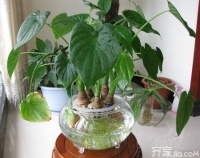柳树( Salix spp.)在污染环境修复中的应用
来源: 时间:2025-01-07 00:51
[1]BERNDES G, FREDRIKSON F, BÖRJESSON P. Cadmium accumulation and Salix-based phytoextraction on arable land in Sweden [J]. Agriculture Ecosystems & Environment, 2004, 103(1): 207-223.[本文引用:1][2]MARMIROLI M, PIETRINI F, MAESTRI E, et al. Growth, physiological and molecular traits in Salicaceae trees investigated for phytoremediation of heavy metals and organics [J]. Tree Physiology, 2011, 31(12): 1319-1334.[本文引用:1][3]FISCHEROVÁ Z, TLUSTOŠ P, SZÁKOVÁ J, et al. A comparison of phytoremediation capability of selected plant species for given trace elements [J]. Environmental Pollution, 2006, 144(1): 93-100.[本文引用:2][4]KUZOVKINA Y A, QUIGLEY M F. Willows beyond wetland s: Uses of Salix L. species for environmental projects [J]. Water, Air, & Soil Pollution, 2005, 162(1): 183-204.[本文引用:1][5]WEIH M, NORDH N E. Characterising willows for biomass and phytoremediation: growth, nitrogen and water use of 14 willow clones under different irrigation and fertilisation regimes [J]. Biomass & Bioenergy, 2002, 23(6): 397-413.[本文引用:2][6]LIU W, NI J, ZHOU Q. Uptake of heavy metals by trees: prospects for phytoremediation [J]. Materials Science Forum, 2013, 743-744: 768-781.[本文引用:1][7]LAUREYSENS I, DE T L, HASTIR T, et al. Clonal variation in heavy metal accumulation and biomass production in a poplar coppice culture. Ⅱ. Vertical distribution and phytoextraction potential [J]. Environmental Pollution, 2005, 133(3): 541-551.[本文引用:2][8]MIRCK J, ISEBRANDS J G, VERWIJST T, et al. Development of short-rotation willow coppice systems for environmental purposes in Sweden [J]. Biomass & Bioenergy, 2005, 28(2): 219-228.[本文引用:2][9]DIMITRIOU I, ARONSSON P. Nitrogen leaching from short-rotation willow coppice after intensive irrigation with wastewater [J]. Biomass & Bioenergy, 2004, 26(5): 433-441.[本文引用:1][10]DIMITRIOU I, ARONSSON P, WEIH M. Stress tolerance of five willow clones after irrigation with different amounts of land fill leachate [J]. Bioresource Technology, 2006, 97(1): 150-157.[本文引用:1][11]MANT C, PETERKIN J, MAY E, et al. A feasibility study of a Salix viminalis gravel hydroponic system to renovate primary settled wastewater [J]. Bioresource Technology, 2003, 90(1): 19-25.[本文引用:2][12]PERTTU K L, KOWALIK P J. Salix vegetation filters for purification of waters and soils [J]. Biomass & Bioenergy, 1997, 12(1): 9-19.[本文引用:1][13]JONSSON M, DIMITRIOU I, ARONSSON P, et al. Treatment of log yard run-off by irrigation of grass and willows [J]. Environmental Pollution, 2006, 139(1): 157-166.[本文引用:1][14]MARLER R J, STROMBERG J C, PATTEN D T. Growth response of Populus fremontii, Salix gooddingii, and Tamarix ramosissima seedlings under different nitrogen and phosphorus concentrations [J]. Journal of Arid Environments, 2001, 49(1): 133-146.[本文引用:1][15]SAMECKA-CYMERMAN A, STEPIEN D, KEMPERS A J. Efficiency in removing pollutants by constructed wetland purification systems in Poland [J]. Journal of Toxicology and Environmental Health, Part A, 2004, 67(4): 265-275.[本文引用:1][16]BÖRJESSON P. Environmental effects of energy crop cultivation in Sweden—I: identification and quantification [J]. Biomass and Bioenergy, 1999, 16(2): 137-154.[本文引用:1][17]SHIN J Y, PARK S S, AN K G. Removal of nitrogen and phosphorus using dominant riparian plants in a hydroponic culture system [J]. Journal of Environmental Science & Health Part A, 2004, 39(3): 821-834.[本文引用:1][18]王红玲, 施士争, 黄瑞芳, 等. 6种柳树对富营养化灌溉污水的氮磷富集能力比较 [J]. 西北林学院学报, 2016, 31(4): 59-66.
WANG H L, SHI S Z, HUANG R F, et al. Comparison of the enriching ability of nitrogen and phosphorus between 6 willow species irrigated by artificial eutrophic water [J]. Journal of Northwest Forestry University, 2016, 31(4): 59-66. (in Chinese with English abstract)[本文引用:1][19]ROGERS A, MCDONALD K, MUEHLBAUER M F, et al. Inoculation of hybrid poplar with the endophytic bacterium Enterobacter sp. 638 increases biomass but does not impact leaf level physiology [J]. Global Change Biology Bioenergy, 2012, 4(3): 364-370.[本文引用:1][20]刘桂青, 杨栋, 倪其军, 等. 内生菌对柳树生长及氮磷吸收的强化作用 [J]. 浙江大学学报(农业与生命科学版), 2016, 42(2): 256-264.
LIU G Q, YANG D, NI Q J, et al. Bioaugmentation effects of endophytic bacteria on growth and nitrogen and phosphorus accumulation of willow [J]. Journal of Zhejiang University (Agriculture & Life Sciences), 2016, 42(2): 256-264. (in Chinese with English abstract)[本文引用:1][21]DA CUNHA A C B, SABEDOT S, SAMPAIO C H, et al. Salix rubens, and Salix triand ra, species as phytoremediators of soil contaminated with petroleum-derived hydrocarbons [J]. Water, Air, & Soil Pollution, 2012, 223(8): 4723-4731.[本文引用:1][22]IONESCU M, BERANOVA K, DUDKOVA V, et al. Isolation and characterization of different plant associated bacteria and their potential to degrade polychlorinated biphenyls [J]. International Biodeterioration & Biodegradation, 2009, 63(6): 667-672.[本文引用:1][23]CORSEUIL H X, MORENO F N. Phytoremediation potential of willow trees for aquifers contaminated with ethanol-blended gasoline [J]. Water Research, 2001, 35(12): 3013-3017.[本文引用:1][24]SCHOENMUTH B W, PESTEMER W. Dendroremediation of trinitrotoluene (TNT) Part 1: Literature overview and research concept [J]. Environmental Science and Pollution Research, 2004, 11(4): 273-278.[本文引用:1][25]SCHOENMUTH B W, PESTEMER W. Dendroremediation of trinitrotoluene (TNT). Part 2: fate of radio-labelled TNT in trees [J]. Environmental Science and Pollution Research, 2004, 11(5): 331-339.[本文引用:1][26]UCISIK A S, TRAPP S. Uptake, removal, accumulation, and phytotoxicity of phenol in willow trees (Salix viminalis) [J]. Environmental Toxicology and Chemistry, 2006, 25(9): 2455-2460.[本文引用:1][27]UCISIK A S, TRAPP S. Uptake, removal, accumulation, and phytotoxicity of 4-chlorophenol in willow trees [J]. Archives of Environmental Contamination & Toxicology, 2008, 54(4): 619-627.[本文引用:1][28]WIESHAMMER G, UNTERBRUNNER R, GARCÍA T B, et al. Phytoextraction of Cd and Zn from agricultural soils by Salix ssp. and intercropping of Salix caprea, and Arabidopsis halleri [J]. Plant and Soil, 2007, 298(1): 255-264.[本文引用:2][29]GRANEL T, ROBINSON B, MILLS T, et al. Cadmium accumulation by willow clones used for soil conservation, stock fodder, and phytoremediation [J]. Soil Research, 2002, 40(8): 1331-1337.[本文引用:1][30]MERTENS J, VERVAEKE P, MEERS E, et al. Seasonal changes of metals in willow (Salix sp. ) stand s for phytoremediation on dredged sediment [J]. Environmental Science & Technology, 2006, 40(6): 1962-1968.[本文引用:1][31]DOS SANTOS UTMAZIAN M N, WENZEL W W. Cadmium and zinc accumulation in willow and poplar species grown on polluted soils [J]. Journal of Plant Nutrition and Soil Science, 2007, 170(2): 265-272.[本文引用:2][32]HAMMER D, KAYSER A, KELLER C. Phytoextraction of Cd and Zn with Salix viminalis in field trials [J]. Soil Use and Management, 2003, 19(3): 187-192.[本文引用:2][33]VANDECASTEELE B, MEERS E, VERVAEKE P, et al. Growth and trace metal accumulation of two Salix clones on sediment-derived soils with increasing contamination levels [J]. Chemosphere, 2005, 58(8): 995-1002.[本文引用:1][34]VANDECASTEELE B, QUATAERT P, TACK F M. The effect of hydrological regime on the metal bioavailability for the wetland plant species Salix cinerea [J]. Environmental Pollution, 2005, 135(2): 303-312.[本文引用:1][35]王银, 王光辉, 胡苏杭. 重金属和有机污染土壤植物增效修复技术研究进展 [J]. 安徽农业科学, 2014, 42(16): 5074-5076.
WANG Y, WANG G H, HU S H. Application of enhanced phytoremediation in contaminated soil by heavy metals and organic pollutants [J]. Journal of Anhui Agricultural Sciences, 2014, 42(16): 5074-5076. (in Chinese with English abstract)[本文引用:1][36]WANG Y, GREGER M. Use of iodide to enhance the phytoextraction of mercury-contaminated soil [J]. Science of the Total Environment, 2006, 368(1): 30-39.[本文引用:1][37]KOMÁREK M, TLUSTOS P, SZÁKOVÁ J, et al. The use of maize and poplar in chelant-enhanced phytoextraction of lead from contaminated agricultural soils [J]. Chemosphere, 2007, 67(4): 640-651.[本文引用:1][38]BAUM C, HRYNKIEWICZ K, LEINWEBER P, et al. Heavy-metal mobilization and uptake by mycorrhizal and nonmycorrhizal willows (Salix×dasyclados) [J]. Journal of Plant Nutrition and Soil Science, 2006, 169(4): 516-522.[本文引用:1][39]EAPEN S, D'SOUZA S F. Prospects of genetic engineering of plants for phytoremediation of toxic metals [J]. Biotechnology Advances, 2005, 23(2): 97-114.[本文引用:1][40]CHEN Y, TANG X, CHEEMA S A, et al. β-cyclodextrin enhanced phytoremediation of aged PCBs-contaminated soil from e-waste recycling area [J]. Journal of Environmental Monitoring, 2010, 12(7): 1482-1489.[本文引用:1][41]YANG C, ZHOU Q, WEI S, et al. Chemical-assisted phytoremediation of Cd-PAHs contaminated soils using Solanum nigrum L [J]. International Journal of Phytoremediation, 2011, 13(8): 818-833.[本文引用:1][42]YU X Z, GU J D. The role of EDTA in phytoextraction of hexavalent and trivalent chromium by two willow trees [J]. Ecotoxicology, 2008, 17(3): 143-152.[本文引用:1][43]PUNSHON T, LEPP N W, DICKINSON N M. Resistance to copper toxicity in some British willows [J]. Journal of Geochemical Exploration, 1995, 52(1): 259-266.[本文引用:1][44]KUZOVKINA Y A, KNEE M, QUIGLEY M F. Cadmium and copper uptake and translocation in five willow (Salix L. ) species [J]. International Journal of Phytoremediation, 2004, 6(3): 269-287.[本文引用:1][45]WATSON C, PULFORD I D, RIDDELLBLACK D. Development of a hydroponic screening technique to assess heavy metal resistance in willow (Salix) [J]. International Journal of Phytoremediation, 2003, 5(4): 333-349.[本文引用:1][46]WATSON C, PULFORD I D, RIDDELLBLACK D. Heavy metal toxicity responses of two willow (Salix) varieties grown hydroponically: development of a tolerance screening test [J]. Environmental Geochemistry and Health, 1999, 21(4): 359-364.[本文引用:1][47]WATSON C, PULFORD I D, RIDDELLBLACK D. Screening of willow species for resistance to heavy metals: comparison of performance in a hydroponics system and field trials [J]. International Journal of Phytoremediation, 2003, 5(4): 351-365.[本文引用:1]
WANG H L, SHI S Z, HUANG R F, et al.
LIU G Q, YANG D, NI Q J, et al.
WANG Y, WANG G H, HU S H.
相关知识
污染环境的植物修复原理
污染环境的生物修复
生物修复在治理土壤污染中的应用
植物修复在污水治理中的研究与应用探析.doc
速生林木对重金属污染土壤植物修复技术研究进展
3环境修复中植物的应用
污染环境的植物修复原理知识讲解
水生植物生态修复技术在景观规划中的应用
植物在污染土壤的修复中的应用
污染环境的植物修复原理解析课件.ppt
网址: 柳树( Salix spp.)在污染环境修复中的应用 https://www.huajiangbk.com/newsview1476713.html
| 上一篇: 基于i |
下一篇: 柳树,绿色生命线的生态效益与社会 |
推荐分享

- 1君子兰什么品种最名贵 十大名 4012
- 2世界上最名贵的10种兰花图片 3364
- 3花圈挽联怎么写? 3286
- 4迷信说家里不能放假花 家里摆 1878
- 5香山红叶什么时候红 1493
- 6花的意思,花的解释,花的拼音 1210
- 7教师节送什么花最合适 1167
- 8勿忘我花图片 1103
- 9橄榄枝的象征意义 1093
- 10洛阳的市花 1039
分享热点排名










